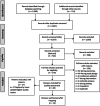Consolidating evidence on the effectiveness of interventions promoting fruit and vegetable consumption: an umbrella review
- PMID: 33430879
- PMCID: PMC7798190
- DOI: 10.1186/s12966-020-01046-y
Consolidating evidence on the effectiveness of interventions promoting fruit and vegetable consumption: an umbrella review
Abstract
Background: The overarching objective was to examine the effectiveness of intervention strategies to promote fruit and vegetable consumption. To do this, systematic review evidence regarding the effects of intervention strategies was synthesized; organized, where appropriate, by the setting in which the strategies were implemented. Additionally, we sought to describe gaps in the review of evidence; that is, where evidence regarding the effectiveness of recommended policy actions had not been systematically synthesised.
Methods: We undertook a systematic search of electronic databases and the grey literature to identify systematic reviews describing the effects of any intervention strategy targeting fruit and/or vegetable intake in children or adults of any age.
Results: The effects of 32 intervention strategies were synthesised from the 19 included reviews. The strategies were mapped across all three broad domains of the NOURISHING framework (i.e. food environment, food system and behaviour change communication), but covered just 14 of the framework's 65 sub-policy areas. There was evidence supporting the effectiveness of 19 of the 32 intervention strategies. The findings of the umbrella review suggest that intervention strategies implemented within schools, childcare services, homes, workplaces and primary care can be effective, as can eHealth strategies, mass media campaigns, household food production strategies and fiscal interventions.
Conclusions: A range of effective strategy options are available for policy makers and practitioners interested in improving fruit and/or vegetable intake. However, the effects of many strategies - particularly those targeting agricultural production practices, the supply chain and the broader food system - have not been reported in systematic reviews. Primary studies assessing the effects of these strategies, and the inclusion of such studies in systematic reviews, are needed to better inform national and international efforts to improve public health nutrition.
Trial registration: The review protocol was deposited in a publicly available Open Science framework prior to execution of the search strategy. https://osf.io/unj7x/.
Keywords: Diet; Health promotion; Nutrition policy; Public health; Recommended dietary allowances.
Conflict of interest statement
The authors declare that they have no competing interests.
Figures
References
-
- Lim SS, Vos T, Flaxman AD, Danaei G, Shibuya K, Adair-Rohani H, et al. A comparative risk assessment of burden of disease and injury attributable to 67 risk factors and risk factor clusters in 21 regions, 1990–2010: a systematic analysis for the global burden of disease study 2010. Lancet. 2012;380(9859):2224–2260. - PMC - PubMed
-
- World Health Organization . Increasing fruit and vegetable consumption to reduce the risk of noncommunicable diseases. 2019.
Publication types
MeSH terms
LinkOut - more resources
Full Text Sources
Other Literature Sources


